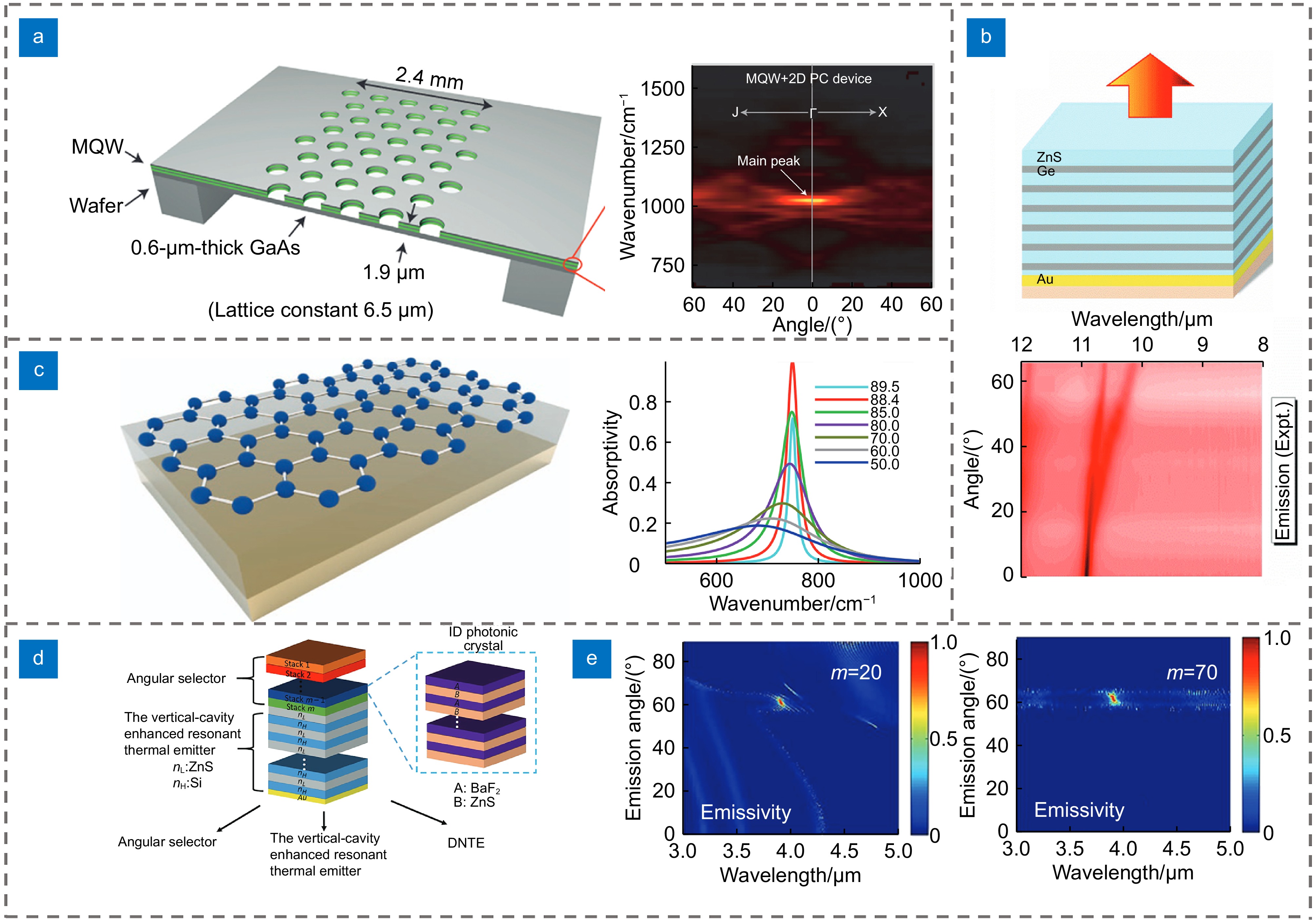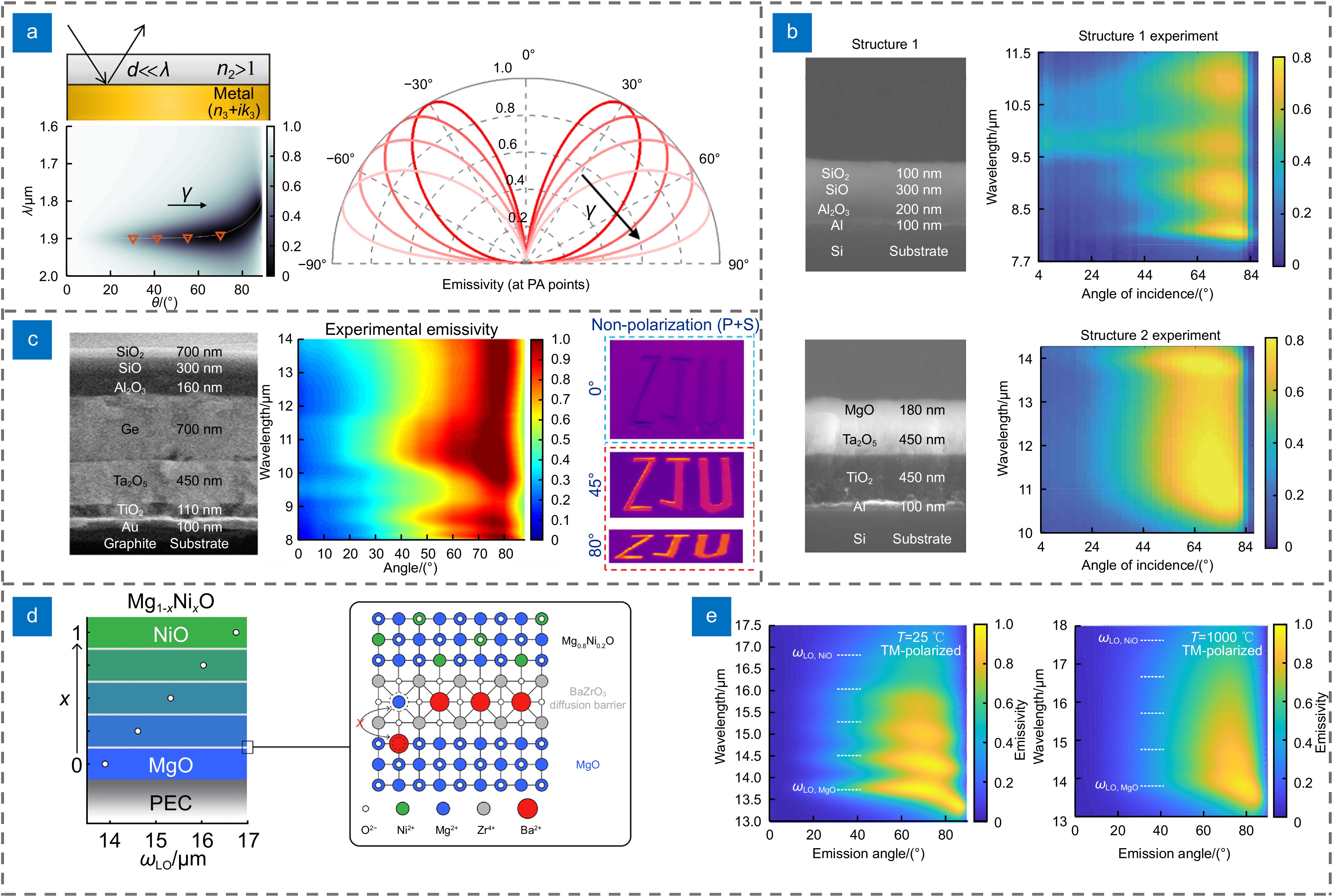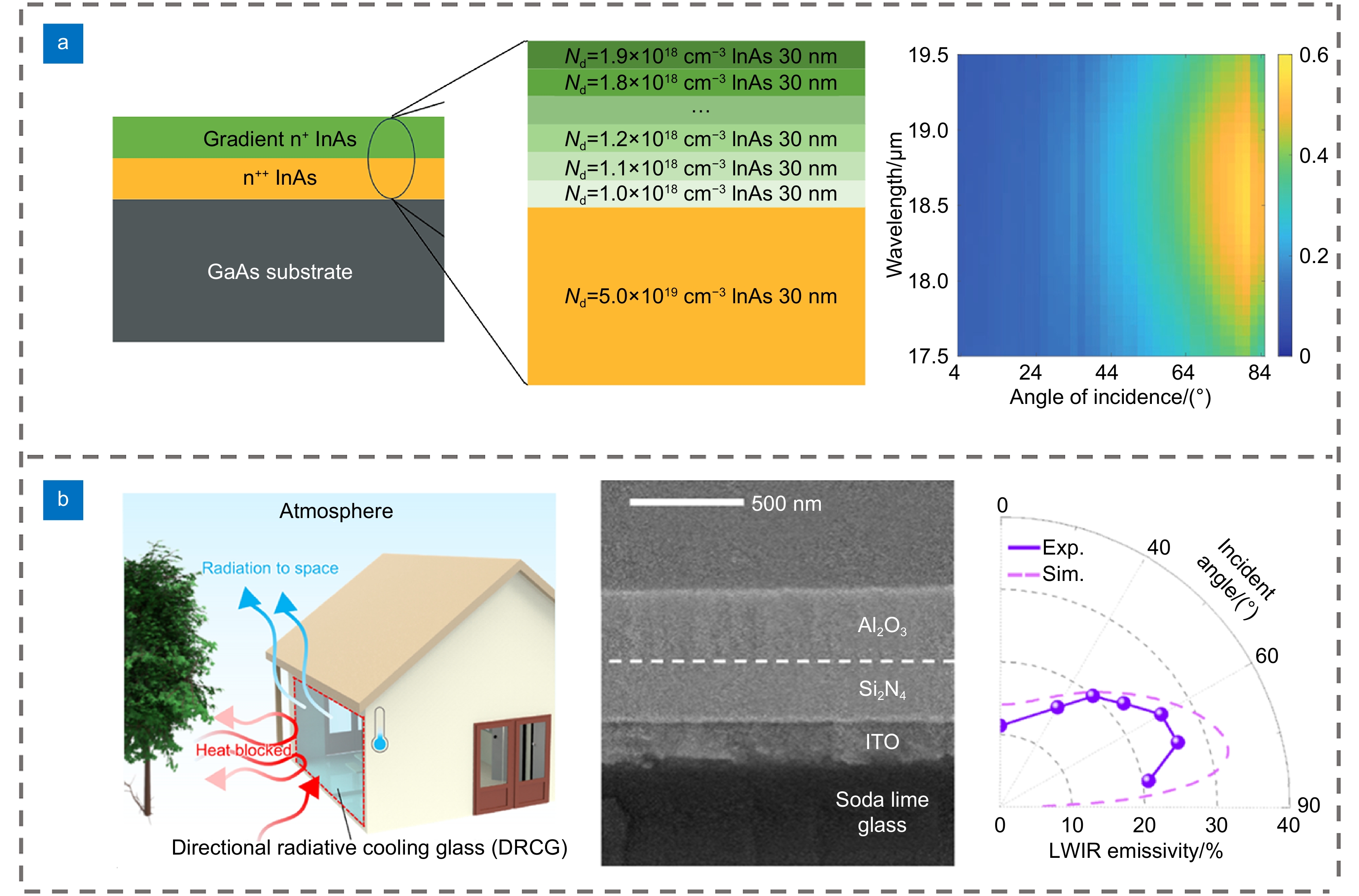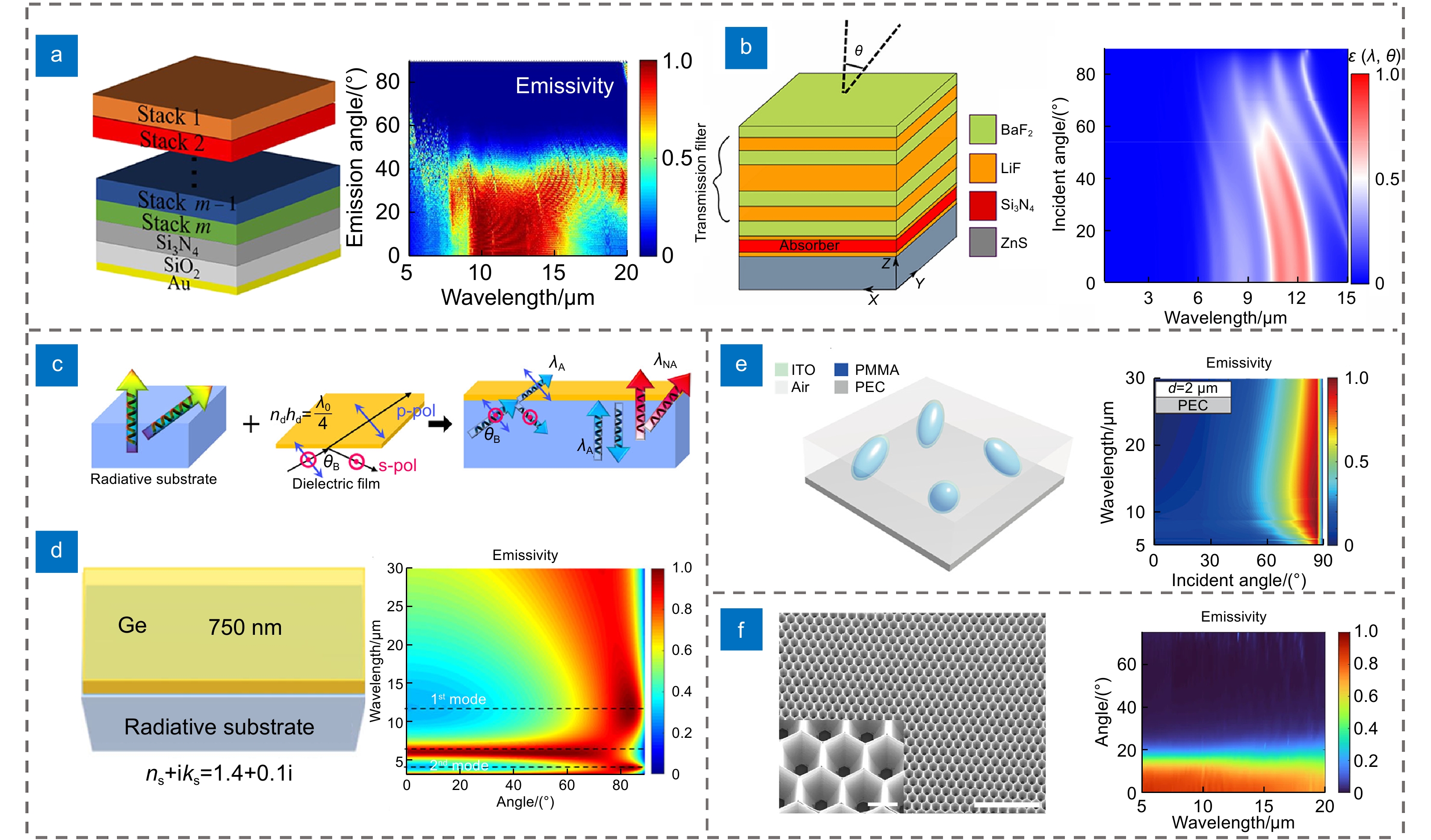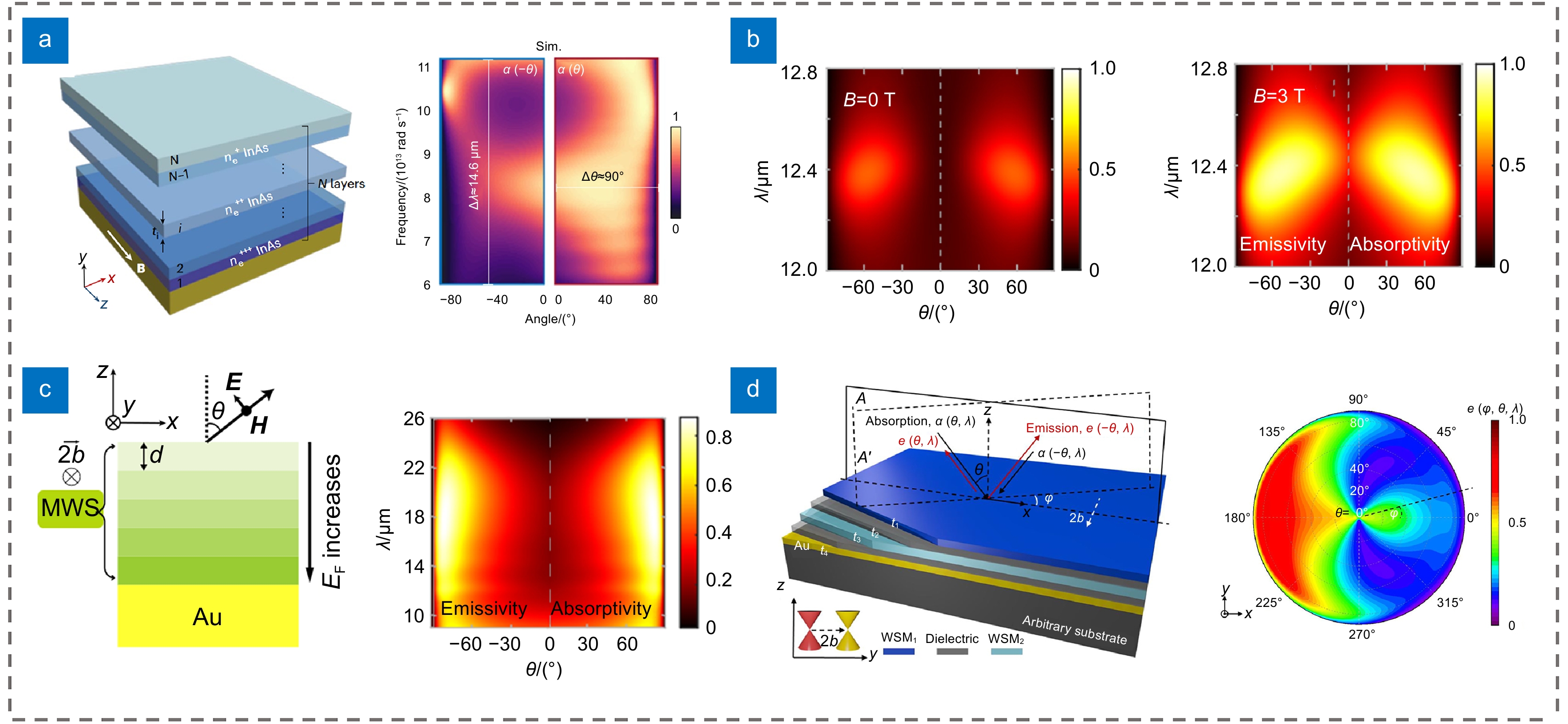-
摘要
热辐射是一种基本的物理过程,指温度高于绝对零度的物体由于粒子的热运动自发地发射电磁能量。大多数热辐射体缺乏方向性,导致能量在不必要的方向上损失,从而降低热器件和应用的效率。在实际应用中,通常需要热辐射器在不同方向上表现出不同的热辐射能力,因此,在高效热传输中,控制热发射的方向性至关重要。定向热辐射的研究对于热成像和传感、辐射冷却、红外加密和能源利用等领域具有重要意义。本文首先阐述了传统热辐射与定向热辐射的区别,以及后者在科学前沿的潜在价值。随后,基于热辐射的特性,从窄带定向热辐射和宽带定向热辐射两个方面系统整理了国内外学者在定向热辐射方面的研究进展。最后,展望了该领域未来的研究趋势,剖析了其面临的重大挑战,旨在为定向热辐射技术的进一步发展提供理论指导与实践启示。
Abstract
Thermal radiation is a fundamental physical process that refers to the spontaneous emission of electromagnetic energy from objects with temperatures above absolute zero due to the thermal motion of particles. Most thermal radiators lack directionality, resulting in energy loss in unnecessary directions, which reduces the efficiency of many thermal devices and applications. In practical applications, thermal radiators are usually required to exhibit different thermal radiation capabilities in different directions, therefore, controlling the directionality of the thermal emission is crucial in efficient heat transfer. The study of directional thermal radiation is of great significance in thermal imaging and sensing, radiative cooling, infrared encryption, and energy utilization. The review first describes the difference between traditional and directional thermal radiation, as well as the potential value of the latter at the frontiers of science. Subsequently, based on the characteristics of thermal radiation, it systematically organizes the research progress of domestic and foreign scholars in directional thermal radiation in terms of both narrowband directional thermal radiation and broadband directional thermal radiation. Finally, future research trends in this field are envisioned, and major challenges are analyzed, aiming to provide theoretical guidance and practical insights for the further development of directional thermal radiation technology.
-
Overview
Overview: Thermal radiation is a fundamental physical process that refers to the spontaneous emission of electromagnetic energy from objects with temperatures above absolute zero due to the thermal motion of particles. Most thermal radiators lack directionality, resulting in energy loss in unnecessary directions, which reduces the efficiency of many thermal devices and applications. In practical applications, thermal radiators are usually required to exhibit different thermal radiation capabilities in different directions, therefore, controlling the directionality of the thermal emission is crucial in efficient heat transfer. The study of directional thermal radiation is of great significance in thermal imaging and sensing, radiative cooling, infrared encryption, and energy utilization. In this context, we classify directional thermal radiation modulation into two categories, broadband and narrowband, and summarize the relevant studies in recent years. The earliest proposed directional modulation was based on grating structures, which realized narrowband modulation. Based on this research, non-reciprocal narrowband directional modulation based on grating structure and narrowband directional modulation based on multilayer film structure were further developed. Due to the theoretical broadband nature of thermal radiation, it is of great significance to realize broadband directional thermal radiation. Broadband directional thermal radiation was first designed through gradient ENZ materials, based on which some researchers have proposed to realize non-reciprocal broadband directional thermal radiation using magnetic gradient ENZ materials. In addition, there are studies on broadband directional thermal radiation based on other materials. Finally, we summarize and analyze the possible future directions and main challenges.
-

-
图 1 基于微纳结构的互易性定向热辐射设计。(a) 基于SiC光栅的首个定向热辐射结构;(b) SiC光栅在p偏振下不同波长和入射角度的发射率[20];(c) 由W或Mo金属表面上等间距同心圆形槽组成的定向热辐射器件[21];(d) 利用Au/SiN/Au超表面结构实现定向和频率选择性热发射[14];(e) 基于Ag/SiO2/Al的超表面,通过磁共振模式控制声子的热发射[22];(f) 由Al/SiN/Al纳米三明治光吸收体的超表面,利用对奇偶对称Fano共振的调控实现热发射的控制[23]
Figure 1. Reciprocal directional thermal radiation design based on micro- and nano-structures. (a) First directional thermal radiation structure based on SiC grating; (b) Emissivity of SiC grating at p-polarization for different wavelengths and angles of incidence [20]; (c) Directional heat radiation devices consisting of equally spaced concentric circular grooves on a W or Mo metal surface [21]; (d) Directional and frequency-selective thermal emission using Au-SiN-Au metasurface [14]; (e) Thermal emission of phonons controlled by magnetic resonance modes based on Ag/SiO2/Al-based metasurface [22]; (f) Control of thermal emission via a metasurface of Al/SiN/Al nanosandwich photoabsorber using modulation of parity-symmetric Fano resonance [23]
图 2 基于多层膜结构的互易性定向热辐射设计。(a) 由MQW层和晶格常数为6.5 mm的二维光子晶体(2D PC)实现小角度的定向热辐射调控[24];(b) 由一维光子晶体(1D PC)薄膜、介质间隔层和连续金属薄膜组成的定向热发射器[25];(c) 由介质间隔层分离Au层与二维材料石墨烯,实现窄带辐射定向调控[27];(d) 通过光子晶体分别设计的热发射器和角度选择器,实现定向热辐射调控;(e)由分别具有20层和70层的角度选择器与热发射器组合,展示定向窄带热发射器的发射率[26]
Figure 2. Reciprocal directional thermal radiation design based on multilayer membrane structure. (a) Small-angle directional thermal radiation modulation achieved by a MQW layer and a two-dimensional photonic crystal (2D PC) with a lattice constant of 6.5 mm [24]; (b) A directional thermal emitter consisting of a one-dimensional photonic crystal (1D PC) film, a dielectric spacer layer and a continuous metal film [25]; (c) Narrowband radiation directional modulation by separating an Au layer from a 2D material graphene by a dielectric spacer layer [27];(d) Directional thermal radiation modulation by photonic crystals designed with thermal emitters and angle selectors, respectively; (e) Demonstration of the emissivity of a directional narrow-band thermal emitter by the combination of an angle selector with 20 and 70 layers, respectively, and a thermal emitter [26]
图 3 基于微纳结构的非互易定向热辐射设计。(a) 单通道和多通道非互易发射器示意图;(b) SiC光栅单向非互易热发射示意图;(c) 设计优化SiC光栅在SPhP 区域中波长和发射角和发射率的关系[35];(d) 非互易多端口发射器示意图以及对应的发射率和吸收率的角分布[36];(e) 由Au/Ge/ZnS/Au制备的变栅结构实现非对称定向热发射结构示意图[37]
Figure 3. Design of non-reciprocal directional thermal radiation based on micro-nanostructures. (a) Schematic of single- and multi-channel non-reciprocal emitters; (b) Schematic of unidirectional nonreciprocal thermal emission from SiC grating; (c) Design optimization of SiC grating in the SPhP region with respect to wavelength and emission angle and emissivity [35]; (d) Schematic of a nonreciprocal multiport emitter and the corresponding angular distributions of emissivity and absorptivity [36]; (e) Schematic of a variable gate structure prepared from Au/Ge/ZnS/Au to realize an asymmetric directional thermal emission structure [37]
图 4 基于ENZ材料实现宽带定向热辐射调控。(a) 由掺杂CdO和SiO2构成的ENZ材料与Au基底结构,实现了窄带定向热辐射调控[44];(b) 分别设计的梯度ENZ材料在7~12 μm和10~14 μm波段内实现了宽带定向热辐射调控[45];(c) 通过介质间隙(Ge)来连接组合两个不同波段实现宽带调控的梯度ENZ材料,覆盖全长波红外(LWIR)范围,实现宽带定向热发射[46];(d) 由耐高温氧化物MgO、BZHO和NiO制成的梯度ENZ超材料,展示了宽带定向热辐射调控的温度不敏感性[47];(e) 不同温度下(25 ℃和1000 ℃)该梯度ENZ超材料的发射率对比图[47]
Figure 4. Realization of broadband directional thermal radiation modulation based on ENZ material. (a) ENZ material consisting of doped CdO and SiO2 with Au substrate realizes narrowband directional thermal radiation modulation [44]; (b) Broadband directional thermal radiation modulation was achieved in the 7-12 μm and 10-14 μm wavelengths by separately designed gradient ENZ materials [45]; (c) A dielectric gap (Ge) is used to connect and combine two gradient ENZ materials with different wavelengths to realize broadband directional thermal emission modulation covering the full long-wave infrared (LWIR) range [46]; (d) Gradient ENZ metamaterials made of high-temperature-resistant oxides MgO, BZHO, and NiO, demonstrating the temperature insensitivity of broadband directional thermal emission modulation [47]; (e) Comparative emissivity plots of this gradient ENZ metamaterials at different temperatures (25 ℃ and 1000 ℃) [47]
图 5 基于ENZ材料实现宽带定向热辐射调控。(a) 通过生长不同掺杂浓度的InAs表征出梯度ENZ,实现定向宽带热辐射的动态调控[48];(b) 基于Al2O3/Si3N4/ITO材料设计了用于垂直表面辐射冷却的透明定向宽带热辐射结构[49]
Figure 5. Realization of broadband directional thermal radiation modulation based on ENZ materials. (a) Gradient ENZ was characterized by growing InAs with different doping concentrations to achieve dynamic modulation of directional broadband thermal radiation [48]; (b) Transparent directional broadband thermal radiation structure based on Al2O3/Si3N4/ITO material designed for vertical surface radiative cooling [49]
图 6 (a) 通过设计光子晶体分别作为热发射器和角度选择器,实现定向宽带热辐射调控[26];(b) 由Si3N4热发射器和由BaF2及LiF组成的顶部透射滤光器构成的结构,实现定向宽带热辐射[50];(c) 与大气窗口匹配的超宽带定向热辐射结构示意图,系统由辐射基底上的薄介质膜组成;(d) 由柔性PEI基底和Ge膜层组成的结构,实现特定方向的宽带热辐射调控[51];(e) 由交替的三相超材料组成的结构,包括椭球形核壳结构阵列和由PMMA覆盖ITO共形涂层的圆柱体阵列,用于实现超宽带定向热辐射[52];(f) 基于SU-8光刻胶基底、聚合物结构和银反射层组成的PDME结构,实现高指向性和宽带特性的热辐射调控[53]
Figure 6. (a) Directional broadband thermal radiation modulation by designing photonic crystals as thermal emitter and angle selector, respectively [26]; (b) Structure consisting of a Si3N4 thermal emitter and a top transmission filter composed of BaF2 and LiF for directional broadband thermal radiation [50]; (c) Schematic of an ultra-broadband directional thermal radiation structure matched to an atmospheric window, with the system consisting of a thin dielectric film on a radiating substrate; (d) Structure consisting of a flexible PEI substrate and a Ge film layer for direction-specific broadband thermal radiation modulation [51]; (e) Structure consisting of alternating three-phase metamaterials, including an array of ellipsoidal core-shell structures and a cylindrical array of PMMA covered with an ITO conformal coating, for realizing ultra-broadband directional thermal radiation [52]; (f) Thermal radiation modulation for high directivity and broadband characteristics based on a PDME structure consisting of SU-8 photoresist substrate, polymer structure, and silver reflective layer [53]
图 7 定向宽带非互易热辐射调控。(a) 利用不同掺杂浓度的InAs薄膜组成梯度磁化ENZ多层膜,实现非互易热辐射调控[66];(b) 单层磁光材料非互易发射器在不同外部磁场作用下的发射率和吸收率的变化;(c) 由Au上方化学势梯度的磁性Wely金属(MWS)层构成的结构,在无外部磁场的作用下可实现定向宽带非互易性热发射[67];(d)由两个具有不同费米能级的WSM层和交替放置在Au反射镜上的介质薄膜组成,可在无外部磁场的作用下实现定向宽带非互易性热发射[68]
Figure 7. Directed broadband non-reciprocal thermal radiation modulation. (a) Gradient magnetized ENZ multilayers composed of InAs films with different doping concentrations are utilized for non-reciprocal thermal radiation modulation [66]; (b) Variation of emissivity and absorptivity of nonreciprocal emitters of single-layer magneto-optical materials in the presence of different external magnetic fields; (c) A structure consisting of a magnetic Wely metal (MWS) layer with a chemical potential gradient above Au enables directional broadband non-reciprocal thermal emission in the absence of an external magnetic field [67]; (d) A structure consisting of two WSM layers with different Fermi energy levels and a dielectric film placed alternately on the Au reflector, which enables directional broadband nonreciprocal thermal emission in the absence of an external magnetic field [68]
-
参考文献
[1] Inoue T, de Zoysa M, Asano T, et al. Realization of dynamic thermal emission control[J]. Nat Mater, 2014, 13(10): 928−931. doi: 10.1038/nmat4043
[2] Coppens Z J, Valentine J G. Spatial and temporal modulation of thermal emission[J]. Adv Mater, 2017, 29(39): 1701275. doi: 10.1002/adma.201701275
[3] Beenakker C W J. Thermal radiation and amplified spontaneous emission from a random medium[J]. Phys Rev Lett, 1998, 81(9): 1829−1832. doi: 10.1103/PhysRevLett.81.1829
[4] Mason J A, Smith S, Wasserman D. Strong absorption and selective thermal emission from a midinfrared metamaterial[J]. Appl Phys Lett, 2011, 98(24): 241105. doi: 10.1063/1.3600779
[5] Jung D, Bank S, Lee M L, et al. Next-generation mid-infrared sources[J]. J Opt, 2017, 19(12): 123001. doi: 10.1088/2040-8986/aa939b
[6] Palchetti L, Di Natale G, Bianchini G. Remote sensing of cirrus cloud microphysical properties using spectral measurements over the full range of their thermal emission[J]. J Geophys Res Atmos, 2016, 121(18): 10804−10819. doi: 10.1002/2016JD025162
[7] Fu Z, Zhong D, et al. Scalable asymmetric fabric evaporator for solar desalination and thermoelectricity generation[J]. Adv Sci, 2024, 20: e2406474. doi: 10.1002/advs.202406474
[8] Zhang R, Song Z, et al. Multispectral smart window: Dynamic light modulation and electromagnetic microwave shielding[J]. Light Sci Appl, 2024, 13: 223. doi: 10.1038/s41377-024-01541-y
[9] Xu G, Kang Q, et al. Inverse-design laser-infrared compatible stealth with thermal management enabled by wavelength-selective thermal emitter[J]. Appl Therm Eng, 2024, 255: 124063. doi: 10.1016/j.applthermaleng.2024.124063
[10] Xu Z Q, Luo H, Zhu H Z, et al. Nonvolatile optically reconfigurable radiative metasurface with visible tunability for anticounterfeiting[J]. Nano Lett, 2021, 21(12): 5269−5276. doi: 10.1021/acs.nanolett.1c01396
[11] Pralle M U, Moelders N, McNeal M P, et al. Photonic crystal enhanced narrow-band infrared emitters[J]. Appl Phys Lett, 2002, 81(25): 4685−4687. doi: 10.1063/1.1526919
[12] Liu X L, Tyler T, Starr T, et al. Taming the blackbody with infrared metamaterials as selective thermal emitters[J]. Phys Rev Lett, 2011, 107(4): 045901. doi: 10.1103/PhysRevLett.107.045901
[13] Morsy A M, Barako M T, Jankovic V, et al. Experimental demonstration of dynamic thermal regulation using vanadium dioxide thin films[J]. Sci Rep, 2020, 10(1): 13964. doi: 10.1038/s41598-020-70931-0
[14] Costantini D, Lefebvre A, Coutrot A L, et al. Plasmonic metasurface for directional and frequency-selective thermal emission[J]. Phys Rev Appl, 2015, 4(1): 014023. doi: 10.1103/PhysRevApplied.4.014023
[15] Shchegrov A V, Joulain K, Carminati R, et al. Near-field spectral effects due to electromagnetic surface excitations[J]. Phys Rev Lett, 2000, 85(7): 1548−1551. doi: 10.1103/PhysRevLett.85.1548
[16] Carminati R, Greffet J J. Near-field effects in spatial coherence of thermal sources[J]. Phys Rev Lett, 1999, 82(8): 1660−1663. doi: 10.1103/PhysRevLett.82.1660
[17] Wolf E. Non-cosmological redshifts of spectral lines[J]. Nature, 1987, 326(6111): 363−365. doi: 10.1038/326363a0
[18] Wolf E, James D F V. Correlation-induced spectral changes[J]. Rep Prog Phys, 1996, 59(6): 771−818. doi: 10.1088/0034-4885/59/6/002
[19] Le Gall J, Olivier M, Greffet J J. Experimental and theoretical study of reflection and coherent thermal emissionby a SiC grating supporting a surface-phonon polariton[J]. Phys Rev B, 1997, 55(15): 10105−10114. doi: 10.1103/PhysRevB.55.10105
[20] Greffet J J, Carminati R, Joulain K, et al. Coherent emission of light by thermal sources[J]. Nature, 2002, 416(6876): 61−64. doi: 10.1038/416061a
[21] Park J H, Han S E, Nagpal P, et al. Observation of thermal beaming from tungsten and molybdenum bull’s eyes[J]. ACS Photon, 2016, 3(3): 494−500. doi: 10.1021/acsphotonics.6b00022
[22] Zhang X, Liu H, Zhang Z G, et al. Controlling thermal emission of phonon by magnetic metasurfaces[J]. Sci Rep, 2017, 7: 41858. doi: 10.1038/srep41858
[23] Zhang X, Zhang Z G, Wang Q, et al. Controlling thermal emission by parity-symmetric fano resonance of optical absorbers in metasurfaces[J]. ACS Photon, 2019, 6(11): 2671−2676. doi: 10.1021/acsphotonics.9b00024
[24] De Zoysa M, Asano T, Mochizuki K, et al. Conversion of broadband to narrowband thermal emission through energy recycling[J]. Nat Photon, 2012, 6(8): 535−539. doi: 10.1038/nphoton.2012.146
[25] Liu X X, Li Z W, Wen Z J, et al. Large-area, lithography-free, narrow-band and highly directional thermal emitter[J]. Nanoscale, 2019, 11(42): 19742−19750. doi: 10.1039/C9NR06181A
[26] Qu Y R, Pan M Y, Qiu M. Directional and spectral control of thermal emission and its application in radiative cooling and infrared light sources[J]. Phys Rev Appl, 2020, 13(6): 064052. doi: 10.1103/PhysRevApplied.13.064052
[27] Zhu L X, Liu F Y, Lin H T, et al. Angle-selective perfect absorption with two-dimensional materials[J]. Light Sci Appl, 2016, 5(3): e16052. doi: 10.1038/lsa.2016.52
[28] Miller D A B, Zhu L X, Fan S H. Universal modal radiation laws for all thermal emitters[J]. Proc Natl Acad Sci USA, 2017, 114(17): 4336−4341. doi: 10.1073/pnas.1701606114
[29] Zhu L X, Fan S H. Near-complete violation of detailed balance in thermal radiation[J]. Phys Rev B, 2014, 90(22): 220301(R). doi: 10.1103/PhysRevB.90.220301
[30] Zhao B, Shi Y, Wang J H, et al. Near-complete violation of Kirchhoff’s law of thermal radiation with a 0.3 T magnetic field[J]. Opt Lett, 2019, 44(17): 4203−4206. doi: 10.1364/OL.44.004203
[31] Zhao B, Guo C, Garcia C A C, et al. Axion-field-enabled nonreciprocal thermal radiation in Weyl semimetals[J]. Nano Lett, 2020, 20(3): 1923−1927. doi: 10.1021/acs.nanolett.9b05179
[32] Tsurimaki Y, Qian X, Pajovic S, et al. Large nonreciprocal absorption and emission of radiation in type-I Weyl semimetals with time reversal symmetry breaking[J]. Phys Rev B, 2020, 101(16): 165426. doi: 10.1103/PhysRevB.101.165426
[33] Landsberg P T, Tonge G. Thermodynamic energy conversion efficiencies[J]. J Appl Phys, 1980, 51(7): R1−R20. doi: 10.1063/1.328187
[34] Green M A. Time-asymmetric photovoltaics[J]. Nano Lett, 2012, 12(11): 5985−5988. doi: 10.1021/nl3034784
[35] Inampudi S, Cheng J R, Salary M M, et al. Unidirectional thermal radiation from a SiC metasurface[J]. J Opt Soc Am B, 2018, 35(1): 39−46. doi: 10.1364/JOSAB.35.000039
[36] Zhao B, Wang J H, Zhao Z X, et al. Nonreciprocal thermal emitters using metasurfaces with multiple diffraction channels[J]. Phys Rev Appl, 2021, 16(6): 064001. doi: 10.1103/PhysRevApplied.16.064001
[37] Yu J B, Qin R, Ying Y B, et al. Asymmetric directional control of thermal emission[J]. Adv Mater, 2023, 35(45): 2302478. doi: 10.1002/adma.202302478
[38] Lucchi E. Applications of the infrared thermography in the energy audit of buildings: a review[J]. Renew Sustain Energy Rev, 2018, 82: 3077−3090. doi: 10.1016/j.rser.2017.10.031
[39] Sakr E, Bermel P. Thermophotovoltaics with spectral and angular selective doped-oxide thermal emitters[J]. Opt Express, 2017, 25(20): A880−A895. doi: 10.1364/OE.25.00A880
[40] Sakakibara R, Stelmakh V, Chan W R, et al. Practical emitters for thermophotovoltaics: a review[J]. J Photon Energy, 2019, 9(3): 32713. doi: 10.1117/1.JPE.9.032713
[41] Raman A P, Li W, Fan S H. Generating light from darkness[J]. Joule, 2019, 3(11): 2679−2686. doi: 10.1016/j.joule.2019.08.009
[42] Raman A P, Anoma M A, Zhu L X, et al. Passive radiative cooling below ambient air temperature under direct sunlight[J]. Nature, 2014, 515(7528): 540−544. doi: 10.1038/nature13883
[43] Yin X B, Yang R G, Tan G, et al. Terrestrial radiative cooling: using the cold universe as a renewable and sustainable energy source[J]. Science, 2020, 370(6518): 786−791. doi: 10.1126/science.abb0971
[44] Johns B, Chattopadhyay S, Mitra J. Tailoring infrared absorption and thermal emission with ultrathin film interferences in Epsilon-Near-Zero media[J]. Adv Photon Res, 2022, 3(1): 2100153. doi: 10.1002/adpr.202100153
[45] Xu J, Mandal J, Raman A P. Broadband directional control of thermal emission[J]. Science, 2021, 372(6540): 393−397. doi: 10.1126/science.abc5381
[46] Ying Y B, Ma B Z, Yu J B, et al. Whole LWIR directional thermal emission based on ENZ thin films[J]. Laser Photon Rev, 2022, 16(8): 2200018. doi: 10.1002/lpor.202200018
[47] McSherry S, Lenert A. Design of a gradient epsilon-near-zero refractory metamaterial with temperature-insensitive broadband directional emission[J]. Appl Phys Lett, 2022, 121(19): 191702. doi: 10.1063/5.0122535
[48] Hwang J S, Xu J, Raman A P. Simultaneous control of spectral and directional emissivity with gradient Epsilon-Near-Zero InAs photonic structures[J]. Adv Mater, 2023, 35(39): 2302956. doi: 10.1002/adma.202302956
[49] Bae M, Kim D H, Kim S K, et al. Transparent energy-saving windows based on broadband directional thermal emission[J]. Nanophotonics, 2024, 13(5): 749−761. doi: 10.1515/nanoph-2023-0580
[50] Chamoli S K, Li W, Guo C L, et al. Angularly selective thermal emitters for deep subfreezing daytime radiative cooling[J]. Nanophotonics, 2022, 11(16): 3709−3717. doi: 10.1515/nanoph-2022-0032
[51] Ying Y B, Yu J B, Qin B, et al. Directional thermal emission covering two atmospheric windows[J]. Laser Photon Rev, 2023, 17(11): 2300407. doi: 10.1002/lpor.202300407
[52] Sarkar M, Giteau M, Enders M T, et al. Lithography-free directional control of thermal emission[J]. Nanophotonics, 2024, 13(5): 763−771. doi: 10.1515/nanoph-2023-0595
[53] Wang Q Y, Liu T J, Li L N, et al. Ultra-broadband directional thermal emission[J]. Nanophotonics, 2024, 13(5): 793−801. doi: 10.1515/nanoph-2023-0742
[54] Fan Z W, Hwang T, Lin S, et al. Directional thermal emission and display using pixelated non-imaging micro-optics[J]. Nat Commun, 2024, 15(1): 4544. doi: 10.1038/s41467-024-48826-9
[55] Brongersma M L, Cui Y, Fan S H. Light management for photovoltaics using high-index nanostructures[J]. Nat Mater, 2014, 13(5): 451−460. doi: 10.1038/nmat3921
[56] Park Y, Zhao B, Fan S H. Reaching the ultimate efficiency of solar energy harvesting with a nonreciprocal multijunction solar cell[J]. Nano Lett, 2022, 22(1): 448−452. doi: 10.1021/acs.nanolett.1c04288
[57] Buddhiraju S, Santhanam P, Fan S H. Thermodynamic limits of energy harvesting from outgoing thermal radiation[J]. Proc Natl Acad Sci USA, 2018, 115(6): E3609−E3615. doi: 10.1073/pnas.1717595115
[58] Li W, Buddhiraju S, Fan S H. Thermodynamic limits for simultaneous energy harvesting from the hot sun and cold outer space[J]. Light Sci Appl, 2020, 9: 68. doi: 10.1038/s41377-020-0296-x
[59] Zhang Z N, Zhu L X. Nonreciprocal thermal photonics for energy conversion and radiative heat transfer[J]. Phys Rev Appl, 2022, 18(2): 027001. doi: 10.1103/PhysRevApplied.18.027001
[60] Pajovic S, Tsurimaki Y, Qian X, et al. Intrinsic nonreciprocal reflection and violation of Kirchhoff’s law of radiation in planar type-I magnetic Weyl semimetal surfaces[J]. Phys Rev B, 2020, 102(16): 165417. doi: 10.1103/PhysRevB.102.165417
[61] Park Y, Asadchy V S, Zhao B, et al. Violating Kirchhoff’s law of thermal radiation in semitransparent structures[J]. ACS Photon, 2021, 8(8): 2417−2424. doi: 10.1021/acsphotonics.1c00612
[62] Hadad Y, Soric J C, Alu A. Breaking temporal symmetries for emission and absorption[J]. Proc Natl Acad Sci USA, 2016, 113(13): 3471−3475. doi: 10.1073/pnas.1517363113
[63] Liu M Q, Zhao C Y. Near-infrared nonreciprocal thermal emitters induced by asymmetric embedded eigenstates[J]. Int J Heat Mass Transf, 2022, 186: 122435. doi: 10.1016/j.ijheatmasstransfer.2021.122435
[64] Ghalekohneh S J, Zhao B. Nonreciprocal solar thermophotovoltaics[J]. Phys Rev Appl, 2022, 18(3): 034083. doi: 10.1103/PhysRevApplied.18.034083
[65] Park Y, Omair Z, Fan S H. Nonreciprocal thermophotovoltaic systems[J]. ACS Photon, 2022, 9(12): 3943−3949. doi: 10.1021/acsphotonics.2c01308
[66] Liu M Q, Xia S, Wan W J, et al. Broadband mid-infrared non-reciprocal absorption using magnetized gradient epsilon-near-zero thin films[J]. Nat Mater, 2023, 22(10): 1196−1202. doi: 10.1038/s41563-023-01635-9
[67] Zhang Z N, Zhu L X. Broadband nonreciprocal thermal emission[J]. Phys Rev Appl, 2023, 19(1): 014013. doi: 10.1103/PhysRevApplied.19.014013
[68] Shi K Z, Sun Y W, Hu R, et al. Ultra-broadband and wide-angle nonreciprocal thermal emitter based on Weyl semimetal metamaterials[J]. Nanophotonics, 2024, 13(5): 737−747 doi: 10.1515/nanoph-2023-0520
-
访问统计


 E-mail Alert
E-mail Alert RSS
RSS
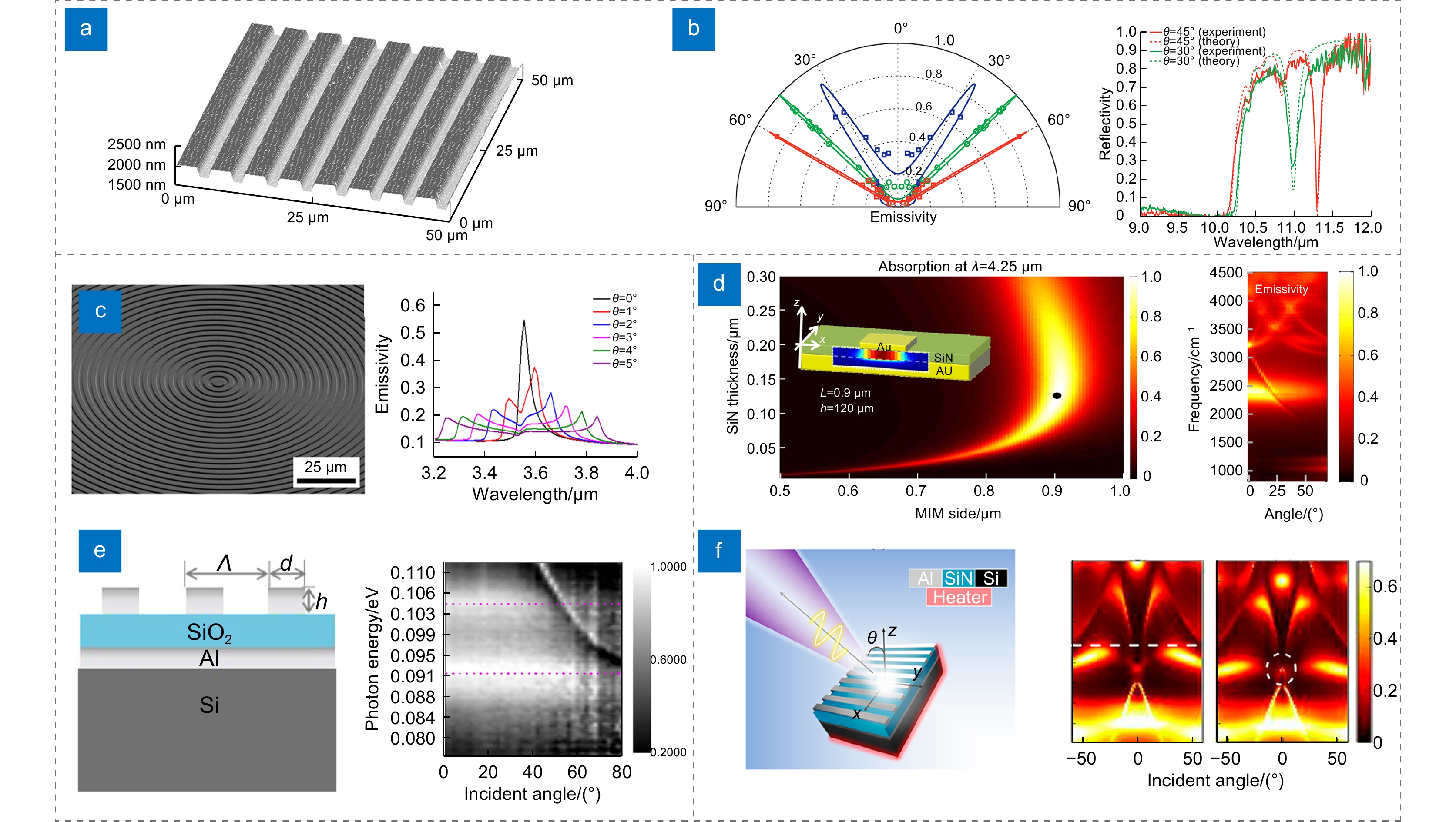
 下载:
下载:
